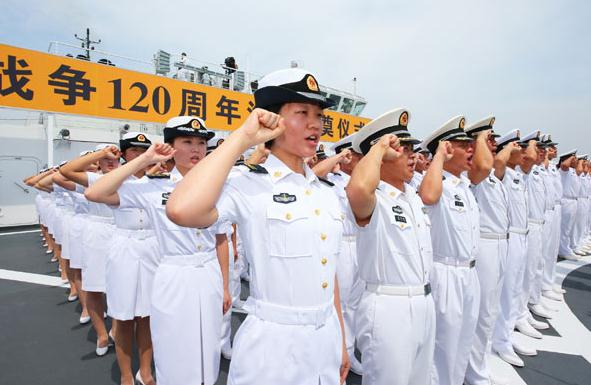

Sailors on a PLA navy cruiser take an oath on Aug 27 off the coast of Weihai, Shandong province. That day marked the 120th year of the start of the First SinoJapanese War (also called the Jiawu War) in 1894. The PLA navy, for the first time in its history, held a maritime memorial ceremony. CHA CHUNMING / XINHUA
120 years after its naval defeat in the First Sino-Japanese War, the country looks to stronger maritime power, Peng Yining reports in Weihai, Shandong province.
At the sound of a steam whistle, the troops on the People's Liberation Army navy cruiser spread white chrysanthemums and red Chinese roses on the waters, where China was defeated during the Jiawu War, or the First Sino-Japanese War, in 1894.
To mark the 120th year of the start of the war, the PLA navy held an unprecedented maritime memorial ceremony off the coast of Weihai in East China's Shandong province.
In the fresh August morning breeze, guns thundered a salute to Chinese troops who died in the war. Naval officers and sailors, including chief commander Wu Shengli, stood in silent tribute.
"The importance of maritime power has long been underestimated, which directly caused us to fail in the Jiawu War," Wu said. "Having the ceremony in the old battle waters is a way to remember this tragic part of history."
Today's China has entered a new era and is unprecedentedly close to the center of the international stage, but still faces a complicated global situation and increasing tension in its maritime territory, Wu said during the ceremony.
"The rise of great nations is also the rise of great maritime powers," Wu said. "History reminds us that a country will not prosper without maritime power.
"China has been exploring oceans, caring about maritime issues and developing the understanding of maritime rights."
Liugongdao history
Not far from the memorial site is the island of Liugongdao. Once the most powerful fleet in Asia, with battleships and cruisers bought from Europe and sailors trained there, the Beiyang Fleet, a major royal naval force of the Qing Dynasty (1644-1911), was headquartered in Liugongdao, where it came to an end when Japanese landed in 1895.
Located in Weihai Bay, the 3-square kilometer island has been a military fortress for centuries. The dock used during the war is still there, with 300 meters of railway tracks that were used to carry coal and cannonballs to the battleships.
Opened to the public in 1985, the island has been a national forest park and Weihai's most popular tourist spot, attracting more than 10,000 visitors a day during holidays.
The remains of many once-mighty ships still lie in the depth of the waters around Liugongdao. Parts of the Jiyuan battleship, including its front guns, have been salvaged and displayed at the site of the Beiyang Fleet headquarters.
Polished and rubbed over countless times by visitors, a used cannon is still set on the island's highest spot facing the East, where the Japanese navy invaded.
"Actually China had one of the best naval forces in Asia before the war, but at that time, China traditionally focused on land defense, neglecting the importance of maritime power, which caused its failure," said Du Jingchen, vice-commander of the PLA navy.
The Beiyang Fleet had more than 4,000 officers and sailors and 25 battleships, Du said. With a displacement of 7,000 tons, ironclad battleships Dingyuan and Zhenyuan were brought from Germany and considered the largest battleships in the world at that time.
Du said the 5,000 years of Chinese history are based on an agrarian civilization. Although China developed the maritime Silk Road in the Han Dynasty and Zheng He, the famed navigator of the Ming Dynasty (1368-1644), helmed seven voyages to Southeast Asia, South Asia and East Africa, its maritime civilization has never been in the mainstream of Chinese culture.
Copyright ©1999-2018
Chinanews.com. All rights reserved.
Reproduction in whole or in part without permission is prohibited.